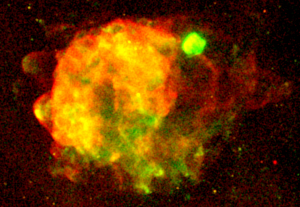Bilateral ejecta jet observed in the remnant of the collapse of a massive star

ROSAT All-Sky Survey image of the Vela SNR (red: 0.1 – 0.4 keV, green: 0.5 – 2.0 keV). The bright source in the upper right is the Puppis A SNR located in the background.
Credit: ROSAT Data Archive, Max-Planck-Institut für extraterrestrische Physik, Garching, Germany
When a massive star ends its life it explodes in a very energetic explosion called a supernova. The ejected stellar matter expands spherically and is in some cases also collimated into jets. If a jet points to us, the explosion is observed as a very intense flash of gamma-ray emission (called gamma-ray bursts, GRBs) due to relativistic beaming. Owing to their high luminosity, GRBs can be detected even if they occur in extremely distant galaxies.
Jets had so far only been resolved and studied in the remnant of the supernova Cassiopeia A, a bright young supernova remnant (SNR) located in our Galaxy. Based on a new observation using the X-ray telescope XMM-Newton, researchers at the Instituto Argentino de Radioastronomía (Argentina) and INAF-Osservatorio Astronomico di Palermo (Italy) discovered antipodal structures indicative of a jet in the nearby Vela SNR. The X-ray emission of these structures show a high abundance of Si, suggesting that the matter originated from the deepest layers of the star that exploded. The new results of this research, in which Prof. Dr. Manami Sasaki of the Friedrich-Alexander University Erlangen-Nürnberg is also involved, have been recently published as a highlight paper in “Astronomy and Astrophysics”.
For more information, please contact
Manami Sasaki
Manami.Sasaki@fau.de
+49 9131 85-81019




